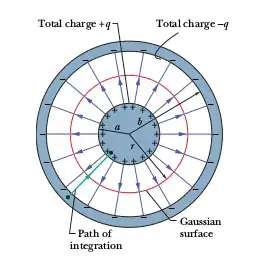I have started learning about the capacitance of the capacitors of various geometries from my textbook. While calculating the capacitance of a parallel plate capacitor, the formula
$$ V_f-V_i=-\int^{f}_{i}\vec E\cdot d\vec s$$
was modified for the present situation as
$$ V=\int^{+}_{-}E\ ds$$
as path of integration starts on the negative plate and ends on the positive plate , opposite to the direction of electric field.
Now below is a part of the method of calculating the capacitance of a cylindrical capacitor from the same text (Fundamentals of Physics, by Halliday, Resnick, and Krane):
As a Gaussian surface, we choose a cylinder of length $L$ and radius $r$, closed by end caps and placed as is shown in Fig. 25-6. It is coaxial with the cylinders and encloses the central cylinder and thus also the charge $q$ on that cylinder. Equation 25.4 then relates that charge and the field magnitude $E$ as $$ q=\epsilon_0EA=\epsilon_0E\left(2\pi rL\right),$$
in which $2\pi rL$ is the area of the curved part of the Gaussian surface. There is no flux through the end caps. Solving for $E$ yields: $$ E={q\over 2\pi\epsilon_0 Lr}. \tag{25-12} $$
Substitution of this result into Eq. 25-6 yields
$$ V=\int^{+}_{-}E\ ds=-{q\over 2\pi\epsilon_0L}\int^{a}_{b}{dr\over r}={q\over 2\pi\epsilon_0L}\ln\left({b\over a}\right), \tag{25-13} $$
where we have used the fact that here $ds=-dr$ (we integrated radially inward).
What I don't understand is why we are again taking $ds = - dr$ as we already did that while modifying the below equation.
$$ V_f-V_i=-\int^{f}_{i}\vec E\cdot d\vec s$$
